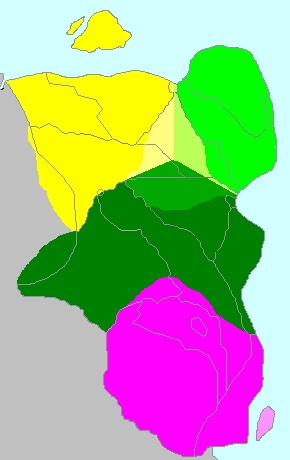The Gáltad
Gáltad is a Hyarmendorean word meaning "people", and today it may refer to modern Dohen or Hälven. Historically, it referred to the Celtic people who conquered and colonized northeastern Alcedonia before the Hispanics.
Contents
History
</div>The Arrival
About the year 500 b. C. a group of Celtic origin, invaded Vassfforcia from the northern shores. They called themselves Gáltad or Dohen (Bolger or even Tochen according to some linguists) and came from a place they called Hyarmendorath ('lands of the south' or 'the far south'). The Dohen were a warring people and before 400 b. C. they had already conquered all the land that today forms the Most Serene Republic of Vassfforcia.
The Conquest
Although the Dohen had a Runic alphabet, not many records of the conquest exist. However, we can still say without much doubt; that the conquest took about a century according to the archaeological evidence. Archaeologists explain this slow conquest because the Dohen were a warring people and that meant they were fighting each other while they were conquering the aborigines. Finally, a document which tells about the siege that kings Çanmoán of the Dohen and Örchetorix of the Gáltad imposed to the city of Bernísbrauh in, according to the saga, the shores of the Lake Azur which the Dohen called Órod’cécenloch.
Four Kingdoms
During the 4th century b. C., after the Neolithic population was conquered and nearly eliminated and the Dohen continued their wars until the beginning of the 3rd century b. C. On this time four kingdoms survived: Bolgerdor or Northern Dohendor in the northwestern plains, Fors in the northeast mountains, Dohendor in the central mountains and northern Ibportia and Hälvendil in today Plenfia and Hilvenídica. After the foundation of these kingdoms and the setting of boundaries between them, peace, prosperity and stability came to the region. However, it is true that there were still some wars among the kingdoms, but those were short and calmed compared to the blood spill of the centuries before.
On the century before the Hispanic invasion and conquest Bolgerdor and Fors were weak while Dohendor was the predominant kingdom in the region. As the four kingdoms were not only independent from each other, but enemies, when the Catalonians came on year 1104 AD, they were able to conquer the northern plains and the northeastern mountains easily thanks to their weakness and the lack of cooperation and interest from Dohendor and Hälvendil.
Culture
</div>Gáltad culture had two mayor pilars, religion and war, as the social order reflects with druids, bards and warriors on the top of the pyramid. It's interesting to remark, that in this society equity between men and women existed, with women being able to become monarchs, druids and even warriors, to the point that in Hälvendil, for example, from year 678 AD on the monarch had to be a queen.
Religion
Dohen religion was an animist one, they believed in the existence of the Véathrim (nature's spirits), which protected the balance of nature. There were Véa for everything, for birth, war, every lake, every forest, every tree, every human being, every stone and every building and they had to be respected in order to keep them in peace and prevent them from destroying whatever they were protecting, thus letting chaos into the Universe. Their most important ceremony took place on fall equinox, when they had to thank the Véathrim for the harvest with nothing else but human blood. Most of the time they sacrificed criminals, but from time to time they needed more captives to be sacrificed and the Ohtajuhlya (Ceremonial Wars) were invented to provide prisoners to be sacrificed to the Véathirm. These tradition, which did not disappeared until the 13th century, was the one which kept the importance of the warriors alive.
The Dohen religion disappeared completely on the beginning of 17th century, when the last pagan Dohen baptized themselves, but its decline began with the coming of the Vassfforcian and Christianity on the 11th century. There were some attempts to go back to this religion on the 1820s, but they weren't successful and today some Neopagan sects (mainly from the Wicca branch) have had some success in the ARD.
Technology
</div>There's evidence that the Dohen (Bolger and Forsian) had an advanced naval technology, but after the conquest of these nations by the Vassfforcians, their technologies were either rejected because they already had something to substitute them or absorbed but sold as Vassfforcian discoveries to the rest of the world.
The Dohen had also important technologies for weapon and armorsmithing. These technologies, with those used for gold and silversmithing were all absorbed by the Vassfforcian conquerors.
The alphabet they brought with was slightly changed, but it remained a Runic alphabet. Their language was also changed into two main variants, the Fors-Bolger dialects in the north and the Dohen-Hälven dialects to the south. The Fors-Bolger dialects disappeared completely after the Vassfforcian conquest, but, on the other hand, the Dohen-Hälven dialects did survive as Dohendor and Hälvendil were not conquered but decided to join the Most Serene Republic. These dialects were finally structured into the Hyarmendorean language in the 1820s by some Hälven and Dohen writers. They used the Latin alphabet and the French and Spanish spelling rules.




